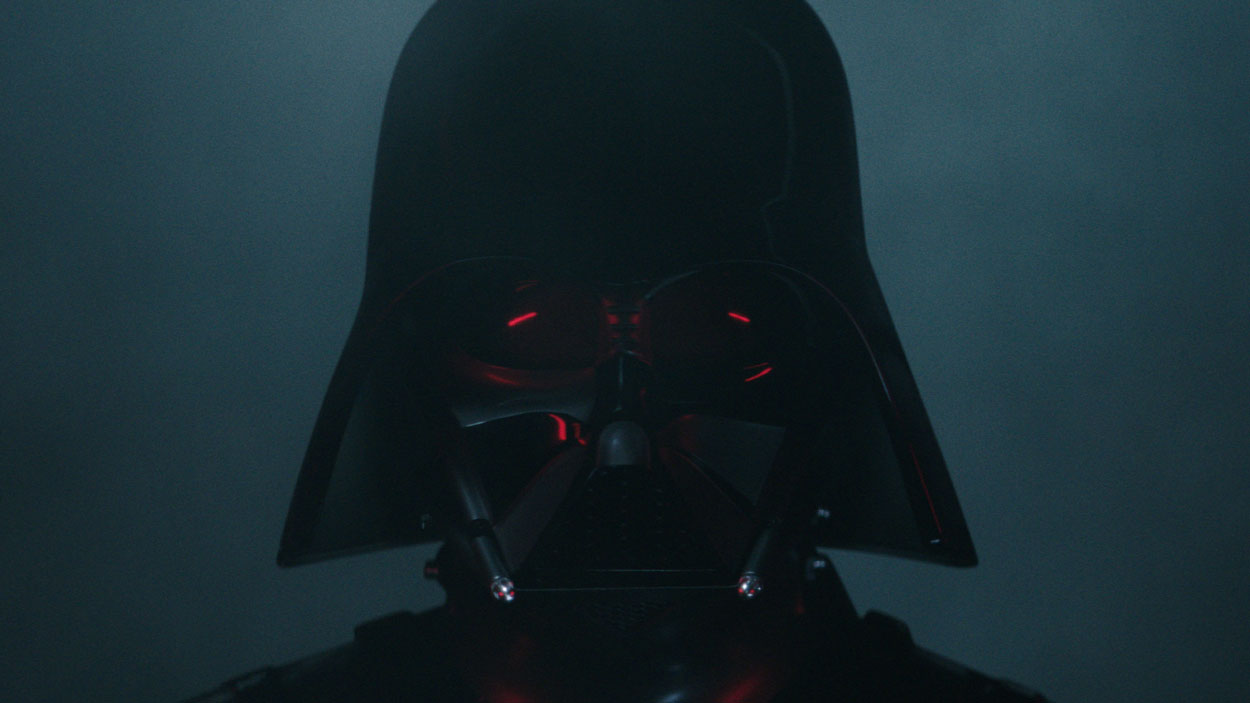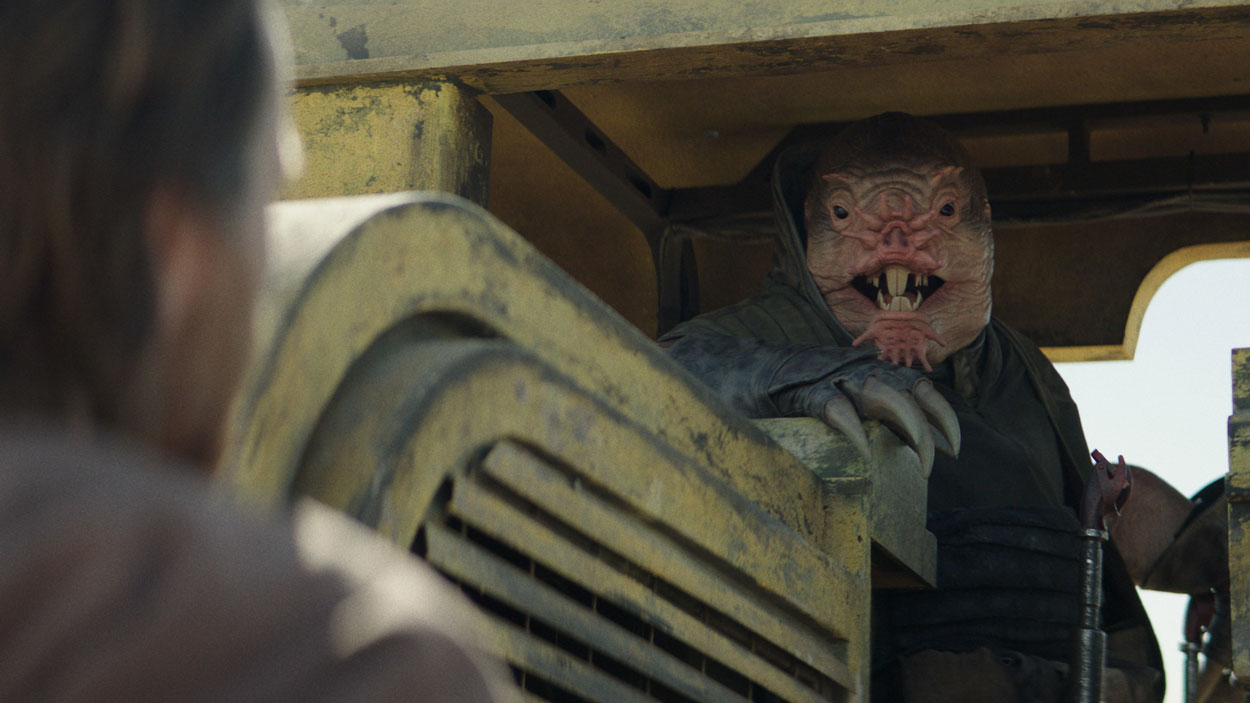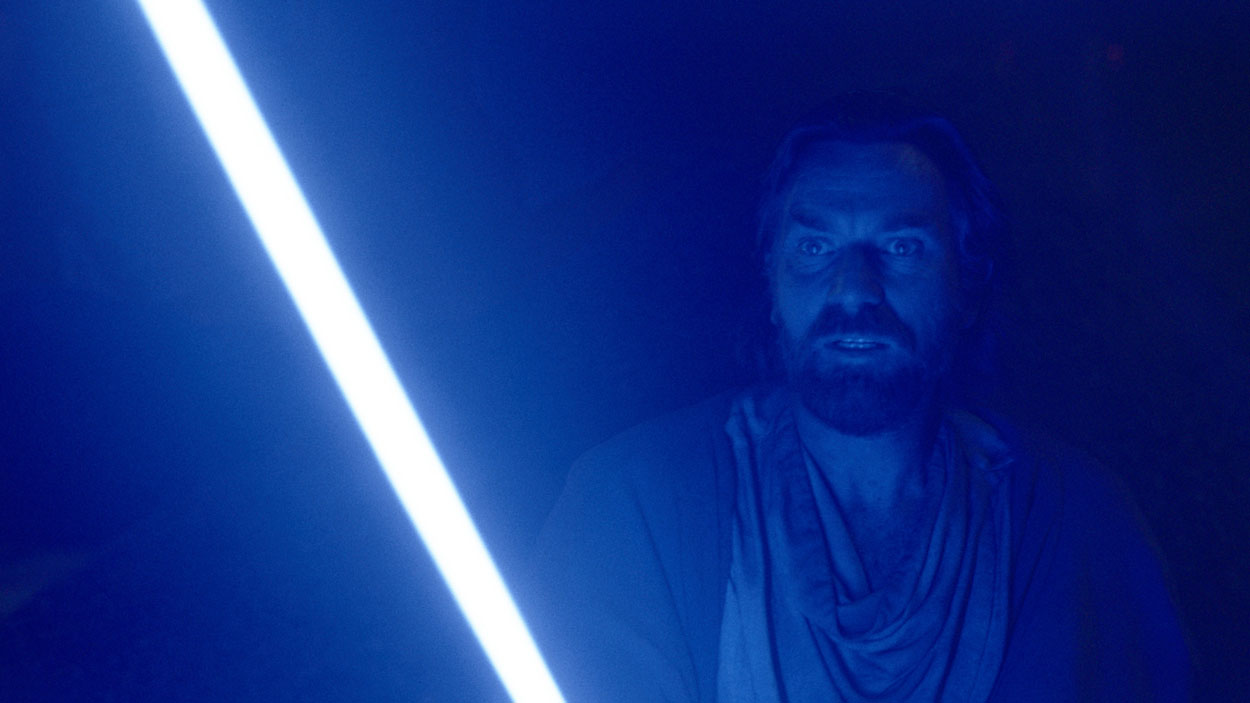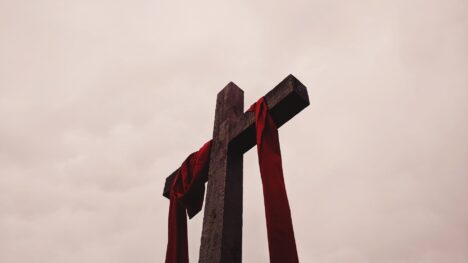Review: Obi-Wan Kenobi, Part III
June 7, 2022

WARNING: The following contains spoilers for Obi-Wan Kenobi Part III.
After a somewhat rocky start to the series, I was intrigued as to where Part III of Obi-Wan Kenobi would take us next. Having narrowly escaped capture at the hands of the Inquisitors and still reeling from the revelation that Anakin Skywalker is still alive, he and Leia find themselves stranded, alone and with no friends on the mining planet of Mapuzo.
The pair waste little time in making their way to the rendezvous point where they hope they’ll find off-world transport to return to Alderaan but to their confusion, their contact is a no-show. It’s these quiet moments in the episode that explore Obi-Wan’s internal struggle. As they trudge through the now barren wasteland, he remarks to Leia that the planet used to be agrarian; farmers and families used to eke out a quiet, undisturbed living here. Due to the Empire’s insatiable hunger for raw materials, the ground is stripped bare and families gone. As with Daiyu, Obi-Wan is confronted with the effects of the fall of the Republic and rise of the Empire. He has seen glimpses of the Empire’s tyranny but Tatooine has remained comparatively untouched. These moments play well into the meta-narrative of the original trilogy; it’s no coincidence that the Empire’s footsoldiers are called stormtroopers (a term that predates Nazism but is certainly associated with it today) or that its machinery and regalia is all in stark blacks, whites and greys. It’s a thinly veiled metaphor for Nazi Germany—which presents its own complicated problems—but it’s also about the military-industrial complex of the 20th century. Beauty and individuality is crushed beneath the uniformity of the Empire, whereas our plucky heroes—be they Luke, Leia, Han, Chewie or even Obi-Wan himself are quirky individualists. It’s also in these quiet moments that we see Obi-Wan’s personal struggle. Anakin looms over him like a ghost; a spectre dancing between what was and what now is. Leia doesn’t know any different but for Obi-Wan, his longing for the old world versus his discontent of the present world is encapsulated in his relationship with Anakin. As he gazes into the horizon, he spots a mirage of Anakin, as if to remind Obi-Wan of his failure and the far-reaching consequences of it.

The pair encounter the friendly, yet Empire-sympathetic Freck
Retconned
We also get a somewhat-retconned insight into Obi-Wan’s past. As he comforts Leia over not remembering her real mother (Padmé Amidala, aka Anakin’s lover) Obi-Wan reveals he too recollects very little of his real family. His clearest memory is having a brother . . . at least, he thinks he did. This is a nod to an abandoned plotline from the original trilogy, where it would later be revealed that Uncle Owen (played by Joel Edgerton in the prequel trilogy and this who) is Obi-Wan’s real brother. Lucas apparently abandoned this plotline, though in some material published years after the original trilogy, in some places Owen is still described as Obi-Wan’s brother.
In Reva’s plotline, she is tasked by Vader himself to find Obi-Wan. She’s promised the title of Grand Inquisitor if she is successful (having maintained the lie that it was Kenobi who ‘killed’ him—I remain unconvinced that he’s truly dead). In true Vader fashion, the promise of reward is offset with a cold threat of retribution if she fails him. She sends out a series of probes (reminiscent of the opening to Empire Strikes Back), eventually locating the pair on Mapuzo. Obi-Wan and Leia eventually meet their contact—a woman named Tala—and prepare to leave the planet when the Inquisitors arrive. However, this time they don’t come alone—Vader is present, as well. Taunting Kenobi by harming innocent bystanders, eventually coming face-to-face at . . . a quarry, of all places.

Anakin flees from Vader amidst a mining quarry
This confrontation is where the episode came apart for me. It’s a long-awaited meeting that the show has been building for the last three episodes but to me, it felt somewhat deflating. The cat-and-mouse chase between the hills came across almost comedic. A particularly unintentionally funny moment came when Obi-Wan is looking around, trying to find Vader in the darkness, only to have Vader suddenly appear out of nowhere, lightsaber swinging. How Obi-Wan didn’t hear the asthmatic machine-man sneaking up behind him is anyone’s guess. I’m also not sold on the location of the duel, though that’s a comparatively minor complaint. In my opinion, the high point of the episode is near the end of its conclusion where Vader has seemingly won—Obi-Wan is weak, overpowered and has little hope of escape. Vader quite literally is roasting him over a hot bed of coals (a clear parallel to the “duel of the fates” in Revenge of the Sith), derisively telling him: “your pain has only begun.” Luckily, our hero is rescued by Tala in the nick of time, spiriting him away from Vader and his stormtroopers in an unlikely but decidedly “Star-Wars-y” way. Internal consistency has never been the franchise’s strong suit, so we perhaps shouldn’t be surprised.
Character Arcs & Hero Journeys
I understand what the showrunners are trying to do in this episode, but I’m not sure it’s working. It’s a common trope even in the Star Wars Universe: our hero encounters the villain early in the story and are beaten. Over time they build the necessary skills/support to defeat the villain in the conclusion. Luke goes through a similar arc with Vader between The Empire Strikes Back and Return of the Jedi, as does Anakin with Count Dooku between Attack of the Clones and Revenge of the Sith. The only problem with this plot device is: we’ve been here before. Anakin and Obi-Wan’s confrontation at the end of Revenge of the Sith is the climactic moment that forever changes the world. Obi-Wan defeats Anakin, yet is ironically defeated himself as the jedi order is toppled. Anakin is mutilated and left for dead yet is later healed and elevated as Darth Vader. Their later meeting in A New Hope finalises this bitter feud: now both old men, Vader easily dispatches Kenobi thanks to his cybernetic enhancements. However, Obi-Wan’s death is not as much a defeat as it is a sacrifice: as he “shuffles off this mortal coil” he transcends life and death itself, becoming “one with the Force” and transforming into a form better able to guide Luke. It’s a deeply spiritual act of sacrifice, clearly influenced by Platonic ideals of the separation of body and spirit and whilst I don’t share such views on the body and soul, I can at least appreciate the way it moves the plot forward.
This is perhaps why the climax fell so flat for me. I had assumed that the showrunners would build the tension slowly, not revealing Vader until close to the conclusion to the series. Pitting the frail, weakened Obi-Wan against the seemingly unstoppable Vader this early on felt cheap. As a result, his subsequent rescue at the 11th hour came off as contrived.
An Omen for Things to Come
It’s clear that we’re headed for a more meaningful confrontation later in the series. Perhaps Obi-Wan will redeem Reva, turning her to the light. Perhaps she will choose to protect Leia or Luke, rejecting her ambitions. Perhaps she will die as a result, sacrificing herself to ensure both the children are kept safe and Obi-Wan able to return to Tatooine in safety. I haven’t read any online leaks; I’m simply going off the story hints we’ve witnessed so far. Reva has a personal vendetta against Obi-Wan, that much is obvious. Why she’s so singularly obsessed with him and no other jedi is a mystery for the moment but we should expect some sort of emotional revelation later in the series. It already seems the showrunners are moving the story in a similar direction to the plot the videogame Star Wars: Fallen Order (not to spoil its plot).
I certainly hope my predictions don’t come to pass. I hope the showrunners surprise us. But if what I’ve predicted does happen, I still have to wonder: “why?” What will this achieve? How will this story contribute to the greater story of Anakin and Obi-Wan? Will it help us see the tragedy and redemption of this tortured character in a more interesting light, or will it simply end up as another cynical Disney cash-grab? The series isn’t over yet, so despite my misgivings I remain optimistic. I just hope the show ultimately does tell the story fans have been asking for all these years and that it’s not a bait-and-switch with Obi-Wan the unfortunate face of what will end up really being the story of Reva, the Third Sister.
Jesse Herford is a pastor and associate editor for the Australian/New Zealand edition of Signs of the Times. He lives in Sydney, Australia with his wife, Carina and their dog, Banjo.









